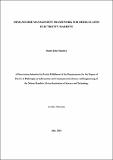| dc.description.abstract | Stability and reliability of electricity grids are at stake because of demand growth rate outstripping
supply, aging of transmission and distribution infrastructure, and the energy sector globally is fast
moving towards incorporating green sources of energy into national grids in order to stabilize and make
the grid more reliable. These challenges have compelled researchers from various sectors to envisage a
modern grid capable of autonomously managing demand, particularly where there is potential for
reduction or shifting demand. Earlier efforts on demand side management of electricity focused on
industrial and commercial consumers. However, residential demand side management programs are
gaining popularity because of decreasing cost of smart meters, coupled with the fact that residences
represent the fastest growing demand and have strongest potential for load reduction or shifting during
peak hours. Works on residential demand side management have largely assumed a single utility
supplying electricity to a number of consumers. Deregulation of the electricity sector such that multiple
utilities offer services, has a potential to improve efficiency and provide value-added services to
consumers. This study has developed a framework of interactions among utilities and between utilities
and residential consumers aiming at improving grid reliability and stability. Using soft-systems
methodology, models for interaction among utilities and between utilities and residential consumers
were developed and evaluated using simulations. Interactions among utilities have been modelled as a
Potluck Problem with non-rational learning so as to establish equilibrium demand and supply, taking
into account past consumption patterns. Interactions between utility and consumers have been modeled
and simulated using token-based scheduling so as to ensure equity and guaranteed access to shared
power capacity established from interactions among utilities. Simulation of interactions and validation
using actual consumption information indicates reduced variability between demand and supply with
Mean Absolute Percentage Error of 5-33% and Peak Average Ratio of up to 27.7% . Consumers can
discretionarily shift their demand at peak hours and save up to 16.6% of electricity cost. Coordinated
use of green energy sources on the consumer side can reduce by up to 23.4% of potential reverse peaks,
thereby decreasing loads dropped because of power capacity constraints. Developing countries
characterized by insufficient generation, demand growth outstripping available supply and limited
access to electricity have an opportunity to sustainably improve stability and reliability of their grids
through the use of demand management programs and therefore may not need to solely rely on
investment in new a generation. | en_US |

